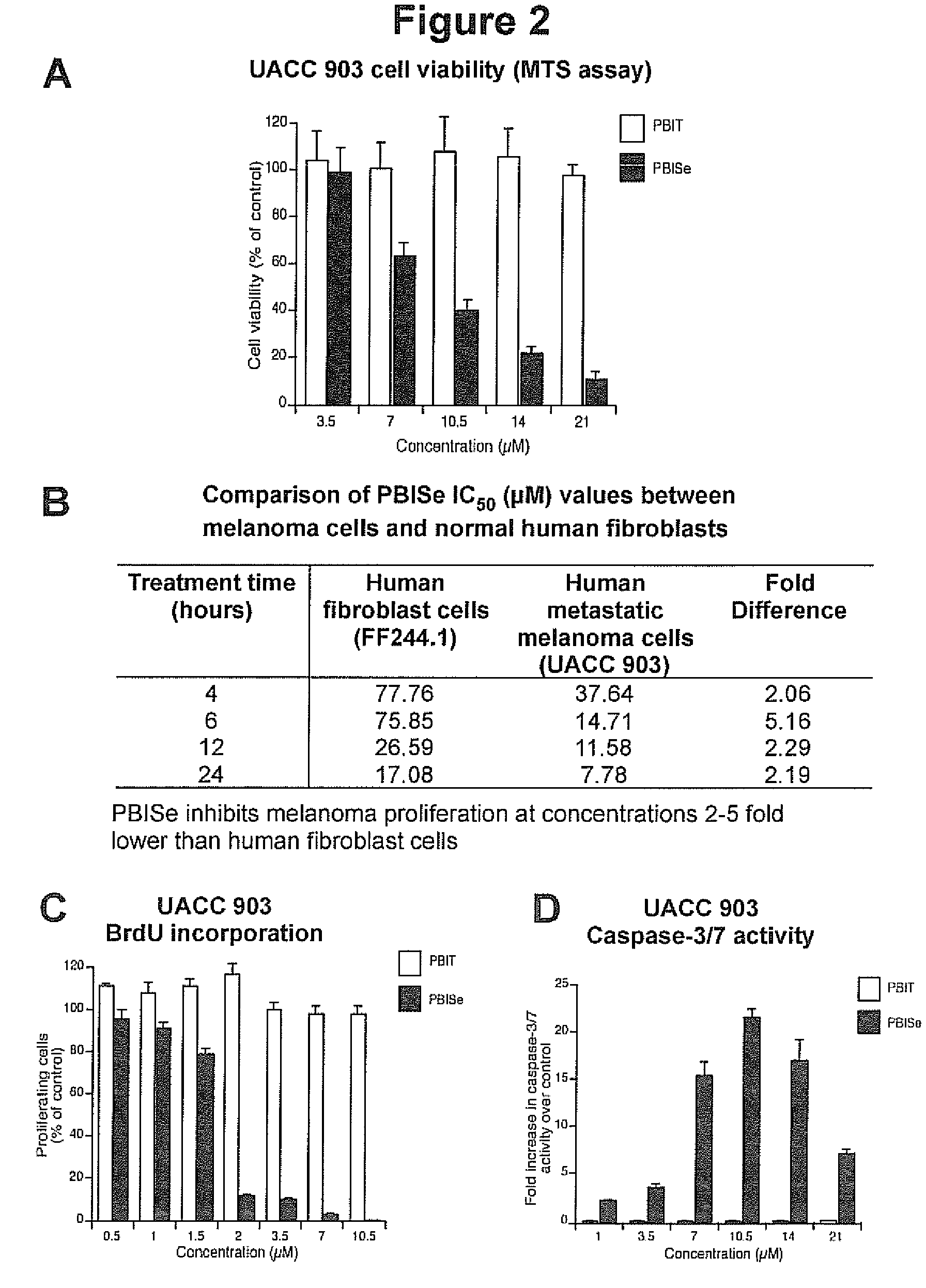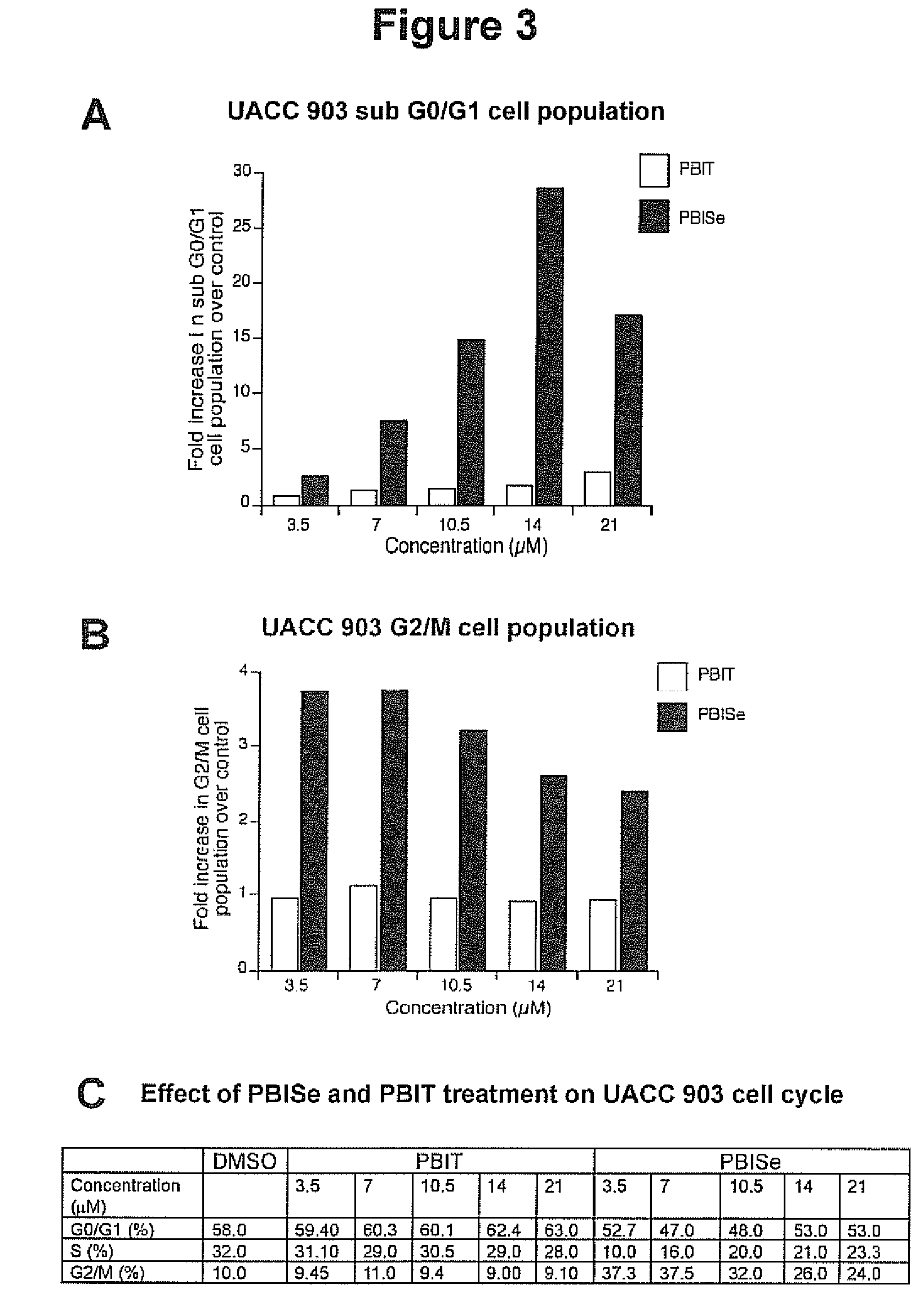Anti-cancer compositions and methods
a composition and anti-cancer technology, applied in the field of anti-cancer compositions and methods, can solve the problems of increased apoptosis of cancer cells, decreased cell proliferation, and melanoma cells
- Summary
- Abstract
- Description
- Claims
- Application Information
AI Technical Summary
Benefits of technology
Problems solved by technology
Method used
Image
Examples
example 1
[0153]Cell lines and culture conditions. Metastatic melanoma cell lines UACC 903 and 1205Lu; lung adenocarcinoma (A549; ATCC No. CCL-185), fibrosarcoma (HT-1080; ATCC No. CCL-121), prostate adenocarcinoma (PC-3; ATCC No. CRL-1435), ovarian adenocarcinoma (NIH:OVCAR-3; ATCC No. HTB-161), normal human fibroblast cells (FF2441) and a breast adenocarcinoma cell line (MDA-MB-231; ATCC No. HTB-26) are grown in DMEM supplemented with 10% FBS. Vertical growth phase (VGP) melanoma cell line WM115 is maintained in Tu2% medium lacking calcium chloride, supplemented with 2% heat treated (56° C. for 30 minutes) FBS and L-glutamine (Mediatech, Handon, Va.) (Stahl, J. M., et al., Cancer Res 2004; 64:7002-10.). Colon adenocarcinoma cell lines (Caco-2; ATCC No. HTB-37., ATCC No. CCL-247., HT-29; ATCC No. HTB-38., SW-480; ATCC No. CCL-228) are grown in Advanced DMEM supplemented with 10% heat inactivated (56° C. for 30 minutes) FBS and 2 mM L-glutamine.
example 2
Synthesis
[0154]Melting points are recorded on a Fisher-Johnson melting point apparatus and are uncorrected. Unless stated otherwise, proton NMR spectra are recorded in CDCl3 using a Bruker 500 MHz instruments. The chemical shifts are reported in ppm downfield from TMS. High-resolution MS are determined on a Finnigan Mat95 instrument at the Penn State University, University Park, Pa. Thin-layer chromatography (TLC) is done on aluminum-supported, pre-coated silica gel plates (EM Industries, Gibbstown, N.J.).
[0155]Selenium-containing compounds, namely S,S′-1,4-phenylenebis(1,2-ethanediyl)bis-isoselenourea (PBISe, 2) and s-2-phenylethylisoselenourea hydrobromide (PEISe, 4) are synthesized as described hereinbelow.
[0156]PBISe, 2, and iNOS inhibitor PBIT, 1, shown below and in FIG. 1A, are prepared as shown in scheme I, a modification of a method described in Garvey, E. P. et al., J Biol Chem, 269: 26669, 1994).
[0157]
[0158]Methyl ester 5 is prepared as reported in the literature by reflux...
example 3
Inhibition of Growth of Colon Adenocarcinoma Cells
[0164]In vitro inhibitory efficacy is measured using 3-(4,5-dimethylthiazol-2-yl)-5-(3-carboxymethoxyphenyl)-2-(4-sulfophenyl)-2H-tetrazolium (MTS) assay (Promega, Madison, Wis.). 5×103 Caco-2 colon adenocarcinoma cells per well in 100 μL DMEM containing 10% FBS are grown in a 96-well plate for 24. Cells are treated with either vehicle control, PBS, PBIT (40-120 μM) or PBISe (2.4-10 μM) for 72 h. The percentages of viable cells compared to control PBS treated cells are determined using MTS assay and IC50 values calculated using GraphPad Prism version 4.01 (GraphPad software, San Diego, Calif.). An IC50 value for each compound is determined by at least three independent experiments and represented with a standard error. FIG. 1B is a graph showing the effect of PBISe and PBIT on colon adenocarcinoma cells. PBISe is significantly more effective having an IC50 of 2.4 μM indicating a 25-fold increase in potency compared to PBIT. Thus, PBI...
PUM
| Property | Measurement | Unit |
|---|---|---|
| body weight | aaaaa | aaaaa |
| weight | aaaaa | aaaaa |
| pH | aaaaa | aaaaa |
Abstract
Description
Claims
Application Information
 Login to View More
Login to View More - R&D
- Intellectual Property
- Life Sciences
- Materials
- Tech Scout
- Unparalleled Data Quality
- Higher Quality Content
- 60% Fewer Hallucinations
Browse by: Latest US Patents, China's latest patents, Technical Efficacy Thesaurus, Application Domain, Technology Topic, Popular Technical Reports.
© 2025 PatSnap. All rights reserved.Legal|Privacy policy|Modern Slavery Act Transparency Statement|Sitemap|About US| Contact US: help@patsnap.com



